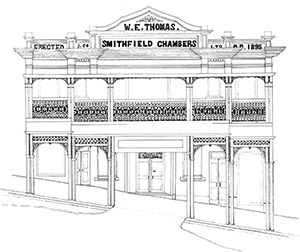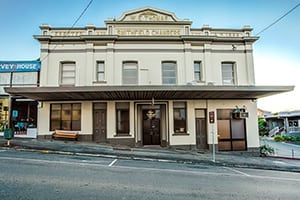Smithfield Chambers
The offices of the legal firm of Power & Cartwright are currently situated on the ground floor of the building known as Smithfield Chambers at 239 Mary Street Gympie.
 Smithfield Chambers is a Late Victorian commercial building constructed of rendered brick. It was erected in 1895 for Mr William Evan Thomas, Mining Secretary. Mr W. E. Thomas was born at Wiston in Pembrokeshire England in 1851. His father was the estate agent of Lord Cawdore and he received his education in the local Nation School. In 1885 a relative who resided in Brisbane persuaded him to emigrate to Queensland. While in the employ of the Hall Mercantile Agency he visited Gympie in relation to estate matters and determined to set up in business on the field as a mining secretary and sharebroker.
Smithfield Chambers is a Late Victorian commercial building constructed of rendered brick. It was erected in 1895 for Mr William Evan Thomas, Mining Secretary. Mr W. E. Thomas was born at Wiston in Pembrokeshire England in 1851. His father was the estate agent of Lord Cawdore and he received his education in the local Nation School. In 1885 a relative who resided in Brisbane persuaded him to emigrate to Queensland. While in the employ of the Hall Mercantile Agency he visited Gympie in relation to estate matters and determined to set up in business on the field as a mining secretary and sharebroker.
Success followed and he became associated with the flotation of mining companies, the taking up of the Australalasian mine and its placement on the market being his first important success. He remained in Gympie until about 1912 when he became interested in the development of new coal measures in Ipswich and up to the time of his death in 1919 was actively associated with the Ipswich Collieries Company as managing director.
Mr W. E. Thomas purchased the block of buildings then situated on the site on which Smithfield Chambers were to be built from Mr M Mellor on 15th November 1894 for £1000. The building was designed by Mr Leslie Gordon Corrie (1859-1918).
Mr L. G. Corrie was born in Hobart, the son of James Affleck Corrie, a Scottish Merchant, and Mary Campbell. He was educated at the Hobart High School and became an articled pupil of Hobart’s leading architect, Henry Hunter. In 1886 he came north to Brisbane. Reference: Donald Watson and Judith Mackay “Queensland Architects of the 19th Century” (Qld Museum, 1994).

The front of the building included classical parapet supported by pilasters ornamented with restrained dentils and parterres on lower part of cornice. Wording in raised moulding between pilasters are featured. On the ground floor there were two shops; the centre being devoted to office accommodation, there being a suite of offices facing the street on each side of the hall, and clerks rooms and boardroom at the back. On the first floor, on the eastern side, there was a suite of three offices, the entrance to which was by a separate staircase; the other portion of the building being divided into five offices and a large boardroom. A special feature of the building was that each suite of offices was provided with a strong room.
The name chosen for the building was Smithfield Chambers after the famous Smithfield mine situated at the One Mile. The Smithfield mine was named after two brothers C. P. and William A. Smith who took up the lease on 5th December 1867.
In 1923 after the closure of the Stock Exchange in Gympie and the sale of the building from which both it and the Stock Exchange Club operated, the Club moved to Smithfield Chambers which was renovated. Frank Power was President of the Stock Exchange Club for 15 years before the Second World War. It was the only club in Gympie in those days and had a membership of 200.
